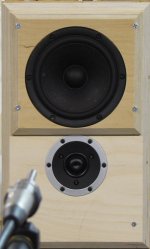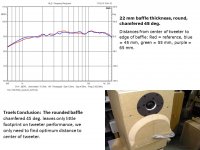I'm aware there is a very similar Adelphos with flat baffle, but I'm interested in trying the minimum phase approach of the Kairos. I also prefer a vertical front baffle.
Would it be all the same if I calculate the C2C offset the Kairos provides by way of its 14 degree incline, and then just set the tweeter back by that much in a vertical stepped baffle?
I'm aware of the edge diffraction issue in the step, but I'm hoping that can be mitigated by thick felt around the tweeter.
Thanks for any input.
B
Would it be all the same if I calculate the C2C offset the Kairos provides by way of its 14 degree incline, and then just set the tweeter back by that much in a vertical stepped baffle?
I'm aware of the edge diffraction issue in the step, but I'm hoping that can be mitigated by thick felt around the tweeter.
Thanks for any input.
B
You have to consider what happens to a speaker off-axis. With the drivers pointing directly at you but designed to be listened too off-axis, you will get more energy at the higher frequencies of the midbass driver and of the tweeter. Or put simply, the frequency response wont be flat any more.
I don't think the expression "minimum phase" is appropriate for the Kairos, but I do believe I get where Jeff was coming from when he used the expression to describe the design. IIRC, the drivers in Jeff's design (a) are wired out of phase, (b) each down by 6db at the crossover point. This means that the woofer and tweeter transfer functions are 180 degrees out of phase at the crossover point, which is a feature of textbook LR2. Maybe I misunderstand, but I think the point of the Kairos is to keep the measured system/total phase as flat as possible through the crossover range.
Regarding the stepped baffle, because there is a geometric discontinuity, felt will simply modify rather than eliminate the effect of the step (www.audioexcite.com >> Satori Two – Monitor). We did numerous experiments about 5 years ago along these lines.
Regarding the stepped baffle, because there is a geometric discontinuity, felt will simply modify rather than eliminate the effect of the step (www.audioexcite.com >> Satori Two – Monitor). We did numerous experiments about 5 years ago along these lines.
Attachments
They're many variables in every listening environment and speaker setup that require adjustment. The difference in stand height or seating height by a couple of inches would account for as much or more variation in response then the stepped baffle. The slight increase in response starting at 10khz probably won't matter much.
People often deal with compromises that are much worse in their listening environment.
Make the baffle removable so if it does not work you can change to the slanted baffle.
People often deal with compromises that are much worse in their listening environment.
Make the baffle removable so if it does not work you can change to the slanted baffle.
A crossover optimized for a slanted baffle is not optimal for a time-step flat-baffle construction.
--The crossover for the slant-baffle Kairos is based upon the 14-degree off-axis SPL measurements of the drivers at the listener.
--The crossover for a flat-baffle, even a flat baffle with a physical time-step, is based upon the 0-degree on-axis SPL measurements of the drivers at the listener.
Google "Diffraction Doesn’t Have to be a Problem" By David Ralph for data on reducing step-edge diffraction by adding felt in different baffle locations. It works - not sexy.
Troels Gravensen experiments with steped baffles with chamfered edge on a rounded step-baffle suggest the diffraction effects can be adequately reduced while providing time alignment value.
Will your amp easily drive the 4-ohm version of the MW16P-4? You can get slightly better dynamics.
Select a cabinet with proved edge diffraction reductions from edge bevels or rounds.
Model your room and speaker-wall placement to estimate crossover baffle-step compensation requirements.
--The crossover for the slant-baffle Kairos is based upon the 14-degree off-axis SPL measurements of the drivers at the listener.
--The crossover for a flat-baffle, even a flat baffle with a physical time-step, is based upon the 0-degree on-axis SPL measurements of the drivers at the listener.
Google "Diffraction Doesn’t Have to be a Problem" By David Ralph for data on reducing step-edge diffraction by adding felt in different baffle locations. It works - not sexy.
Troels Gravensen experiments with steped baffles with chamfered edge on a rounded step-baffle suggest the diffraction effects can be adequately reduced while providing time alignment value.
Will your amp easily drive the 4-ohm version of the MW16P-4? You can get slightly better dynamics.
Select a cabinet with proved edge diffraction reductions from edge bevels or rounds.
Model your room and speaker-wall placement to estimate crossover baffle-step compensation requirements.
Attachments
Unfortunately the rounded step-baffle is also the least attractive. Just another example of nature and beauty don't go together. Why I am not surprised?Troels Gravensen experiments with steped baffles with chamfered edge on a rounded step-baffle suggest the diffraction effects can be adequately reduced while providing time alignment value.
Unfortunately the rounded step-baffle is also the least attractive. Just another example of nature and beauty don't go together. Why I am not surprised?
agreed, that's why I use a big piece wool felt.
Edwin Abbot, the author of "Flatland" might have a different viewpoint.
Clever shape and construction of a grill cloth can hide the stepped baffle...even the really ugly straight cut step.
The round + chamfered step baffle transforms into form + function style with several coats of high-gloss black paint.
Clever shape and construction of a grill cloth can hide the stepped baffle...even the really ugly straight cut step.
The round + chamfered step baffle transforms into form + function style with several coats of high-gloss black paint.
- Status
- This old topic is closed. If you want to reopen this topic, contact a moderator using the "Report Post" button.
- Home
- Loudspeakers
- Multi-Way
- Jeff Bagby Kairos with flat stepped baffle?

